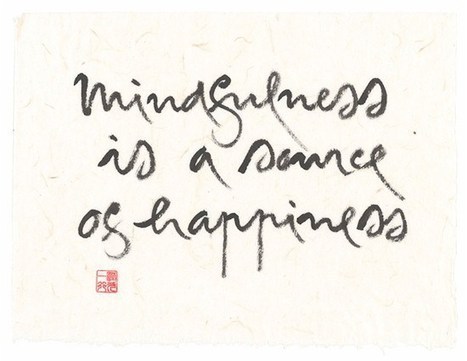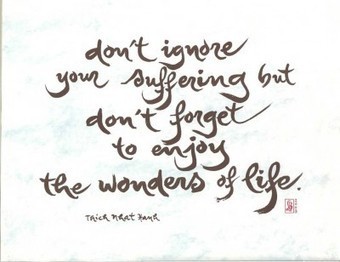 Your new post is loading...
 Your new post is loading...
We now have the scientific evidence to back up those claims. Research conducted by Greg Feist of San Jose State University found that when people let their focus shift away from others around them, they're better able to engage in "metacognition," the process of thinking critically and reflectively about your own thoughts. Where things get tricky, though, is figuring out what to do in order to encourage metacognitive thought in the first place. When we're routinely overwhelmed with outside noise, carving out space for unstructured daydreaming takes planning, structure. Sometimes the most productive periods of contemplation come to us unawares and don't last very long—but that doesn't mean they aren't useful.
Via Ivon Prefontaine, PhD
Imagine the colleague with whom you have a very challenging relationship, the person who makes the most innocuous conversation tense and uncomfortable. Regardless of the topic, this person opposes you and approaches things as an adversary rather than an ally. Once you can visualize that person vividly and even viscerally, imagine the following scenario: You’re sitting at your desk working away when a message from that person pops up on your screen. You open the message and it reads: “I got the draft presentation you sent. I caught a couple of mistakes, and I have some ideas for how to make it better. I’ll drop by your office at 3 PM to discuss.”
Via The Learning Factor
I first learned about mindfulness at the moment I needed it the most: I was referred to the mindfulness work of Dr. Jon Kabat-Zinn, professor emeritus of the University of Massachusetts Medical School by my surgeon after breaking both my ankle and top of my foot in an accident. (Disclosure: I am perfectly fine now, but my tennis game is not!) At the time, I was looking for a way to observe and reflect on my physical discomfort. I soon found that mindfulness, once considered a fringe movement in the Western world, is now being incorporated into medicine, science and the workplace. As I began to practice meditation through the tapes and books of Dr. Kabat-Zinn, I started exploring how mindfulness was also being used inside companies, including Aetna, Keurig Green Mountain, Intel, Google, General Mills and many others. In fact, at this year’s World Economic Forum, mindfulness was one of the hottest topics, with multiple sessions not only devoted to the science behind mindfulness but also how to practice it.
Via Maria Rachelle
They aren't the uni-dimensional individuals their online mug shots might suggest, but rather living, breathing, thinking and feeling human beings with aspirations, abilities and of course, regrets.
Via Jenny Ebermann, MyKLogica
Siete falacias sobre el mindfulness, la filosofía que se ha puesto de moda El mindfulness consiste en prestar atención de forma consciente al momento presente, pero hay muchas personas que se equivocan al intentar practicarlo
Via MyKLogica
Ya sé que estamos inmersos en una cultura que valora mucho la prisa, el mensaje corto y directo y el "no te enrolles y ve al grano". Quizás por eso tienen tanto éxito Twitter y otras formas de microblogging, o los comentarios cortos en Facebook. Nos garantizan que no nos van a requerir más de unos segundos y, si lo hacen, que podemos pasar al siguiente que seguro que es corto y jugoso.
Por eso me he pensado compartir este vídeo y su comentario. Es larguísimo para los estándares de "dígalo en un minuto". Y al final me he dicho "seguro que habrá quienes no sean capaces de dedicar veinte minutos y veinte segundos a verlo... peor para ellos". Los demás, los que sí sean capaces de verlo con la necesaria atención, van a poder disfrutar de unas interesantísimas reflexiones acerca de cómo las base de la empatía, el sentido de pertenencia y la cohesión social se fundamentan en la autoestima. Pero no en la autoestima de quienes subrayan sólo "lo positivo" o recitan "autoafirmaciones positivas", no. Precísamente en la autoestima de quienes, sabiéndonos imperfectos y vulnerables, aceptamos nuestra imperfección y nuestra vulnerabilidad... lo que nos capacita para aceptar la de los demás. Aceptar lo que no nos gusta de nosotros no significa resignarnos a ello, ya hemos hablado de eso en otra ocasión. Sin embargo, no aceptarnos es la base de la vergüenza y de los sentimientos de indignidad, de no ser lo suficientemente lo que sea y de no ser lo suficientemente buenos para merecer no sé qué. Hay dos grandes antídotos para la vivencia dolorosa de la vulnerabilidad: la negación a través de sesgar la percepción hacia "lo positivo" y la aceptación a través de la autoestima y la empatía. Bueno, también están los psicópatas, pero esos es que ni llegan a percibir su incompletud y, quizás por eso, son incapaces de empatizar. Así que aceptémonos con amor por nuestra propia imperfección, eso nos hará más sosegados y empáticos. Y hagámoslo con coraje, es decir, con la apertura de corazón necesaria para mostrarnos como somos, ante nosotros y ante el mundo.
Estamos asistiendo a una especie de explosión en la difusión de conceptos relacionados con la práctica de mindfulness; de lo que no estoy tan seguro es que la práctica de mindfulness se esté increm...
El mes pasado hablaba de la Actitud Mental Positiva e invitaba a que se busque por gente con AMP en tiempos difíciles, pues son los que más te pueden inspirar.
El cerebro necesita el corazón para pensar, para activar el organismo y relacionarnos con los demás.
Where do you focus your impatience? Is it focused on your important things in life? Our life needs the right balance to keep our pace and stride focused. Dividing our patience and impatience between unimportant and important life and leadership activities delivers a better view for us to absorb. Routine – There are unimportant activities we need to do. In terms of life direction, they are the functional things we need to do, and we do them with a patient everyday mindset. Release – These are the frustration points that unexpectedly land in our path. We need to take a more mindful approach to resolved them, breathing in and letting the impatience flow from our thoughts and actions. We cannot let them trip us up and get us off track. Pace – For some of our important activities, we get riled up. We need to remember to put one foot in front of another. It is about movement, not just motion. It is about consistency of work and effort to achieve our goals and purpose. Scurrying around tires us out; consistent action delivers better results. Stride – Life is a balance. We cannot become too patient in achieving our life purpose, as life may just pass us by. For the important things in our life, we need to gain and maintain our stride.
Via David Hain, Ricard Lloria
|
Is there a colleague with whom you have a strained working relationship? If, by chance, you are some kind of work superhero who just answered “no” to that question, is there at least someone with whom you would like to have a better relationship? If so, please ask yourself the following questions in relation to that person: Do you notice him as he truly is today, or based on your memory of how he was last week or last month – or even last year?When you have a conversation with him, is your only aim to change his mind? Or also to change your own?When you see his name in your inbox, do you already have a “story” about him, before even opening the email? These issues get to the heart (and brain) of executive mindfulness. While we know from research that mindfulness is good for us, what seems to be missing from the conversation is how one might be mindful at work, without meditating at our desks or breaking into a sun salutation. But an understanding of mindfulness – how it really operates in the context of daily work activities – is essential to good working relationships; relationships that let both us and our coworkers grow and change over time.
Via The Learning Factor
When you think of relaxation, you think of meditating in the morning, or taking a hot bath at night—perhaps a glass of wine is in the picture too. But sometimes, when your day gets crazy stressful, you need something to calm you down right then and there. These simple exercises will do the trick.
Via The Learning Factor
Desde ese día disfruto de esa sencilla enseñanza que enriquece mi vida, aportándome calma y conciencia a mi persona, uniéndome además a lo que me rodea.
Durante años de profesión he trasmitido este mismo ejercicio a mis pacientes y ellos me han contado de su eficacia, del placer que es comenzar el día concentrándose en los cinco sentidos y de cómo dedicar unos minutos a dar “Los buenos días” te hace comenzar el día con otras emociones.
Via Marta Torán
¿Cómo debería ser la educación para promover una mente plena y creativa?
Author and business adviser Greg McKeown believes that each of us falls into one of two groups: essentialists and non-essentialists. Essentialists are men and women who make wise investments of their time and energy in order to "operate at their...
Via craig daniels, Ivon Prefontaine, PhD
Tools - give me tools. That’s what most of the people we meet in the workplace want – tools. Tools to be more efficient, productive, effective and less stressed. Often what they want are soluti...
Via Jenny Ebermann, MyKLogica
"What is mindfulness? It’s often described as being “in the moment.” Yet it’s much more than that. Hear Jon Kabat-Zinn, Professor of Medicine Emeritus and founding director of the Stress Reduction Clinic and the Center for Mindfulness in Medicine, Health Care, and Society at the University of Massachusetts Medical School, as he explains mindfulness as: “the awareness that arises through paying attention, on purpose, in the present moment – and non-judge-mentally.” Seems simple enough, doesn’t it? But this short video could make you aware of how UNaware you may be!"
Via David Hain
Hace unos días, leyendo vivirconpanyaceitedeoliva, el blog de Gustavo Higueras, me reencontré con un vídeo que me gustó. Ya lo había visto hace tiempo, me resultó simpático, pero no me guardé la re...
Quizá pienses que la meditación, la relajación o las prácticas de atención plena te van a convertir en otra persona. Quizá seas de quienes ven esa posibilidad con buenos ojos, porque puede que no t...
Finalmente y después de muchos años de perseverante determinación, pudo descubrir cómo mirar tras los velos que ocultan la realidad. Lejos quedaban aquellos años de infancia y juventud en los que, ...
It’s getting difficult not to bump into the word mindfulness these days. While mindfulness is mostly associated with meditation, I like to think of it as a way of being in the world. Mindfulness meditation “practice” is valuable – and it will likely have multiple ripple effects in every corner of your life. A new study at The University of Utah has confirmed its benefits and shown that mindfulness affects stress responses throughout the day. According to researcher Holly Rau, “People who reported higher levels of mindfulness described better control over their emotions and behaviors during the day.” Magic? No. Methodical practice of retraining the brain to respond to stimulus differently builds cognitive flexibility in ways we are just beginning to understand. In an age of looking outside of ourselves for solutions, mindfulness practice turn out to be the ultimate insider “strategy.” The magic of mindfulness is that it rearranges neural networks in powerful ways. And the great news is that we are the “tool” that makes it possible. Apps can remind us when to breathe, sit and slow down, but only we can make it happen. Sitting on the “Cushion” is the “Easy” Part It took me a long time to establish a regular mediation practice. My resistance wasn’t very creative. Like many of us, I was too busy, too distracted and too hesitant to sit down with myself and do “nothing.” While I had long admired many mindfulness practitioners around me, I couldn’t get my act together to block out a small chunk of time everyday to sit. Fortunately, I did establish a daily practice. Meditation practice has been one of the best gifts I’ve ever given myself. But soon I realized that my mindfulness practice didn’t have to be confined to meditation. Meditation is the anchor. The real practice was to stay mindfully present to what was happening around me – on the cushion – and off. Several Zen teachers, like well-known American Roshi Bernard Glassman have used the metaphors of cooking to demonstrate that every task of life offers an opportunity to practice acts of mindfulness. In their Instructions to the Cook, Glassman and Tricycle editor Rick Fields write, “When we cook-and live-with this kind of attention, the most ordinary acts and the humblest ingredients are revealed as they truly are.” The authors point out that when we practice mindful attention, every ingredient is used in the cooking. “Our body is an ingredient, our relationships are ingredients. Our thoughts, our emotions and all our actions are ingredients. With practice, our territory expands and all the objects of the world become our ingredients.” Communicating with others can offer one of the greatest opportunities to practice mindfulness. Our daily communication with family, friends and work colleagues is filled with abundant possibilities to stay present to how we feel and act – moment to moment. Practicing mindful communication necessitates that we slow down and allow ourselves to really look at the choices we make with others. While it may be easy to communicate with kindness and respect to those we care about, how far does that regard extend to those who try our patience? How considerate are we with people we’ll never meet again? How gracious are we when pressures mount? How mindful do we believe we should be with people we don’t like? In considering the mindful treatment of others, I often recall the sterling advice of Buddhist scholar and teacher Robert Thurman. Asked by several of my classmates how to practice mindfulness most effectively, the often jocular professor suggested that we all get a cup of coffee from the corner “deli” as a start. His remarks left several students baffled; Thurman elaborated, “The guy in the deli doesn’t have a very exciting job. He’s not well paid and people give him a hard time all day.” How do you treat him? Are you kind? Are you impatient? Do you ask how his day is going? This is mindfulness practice – the nitty-gritty mechanics of daily life. How we act is a reflection of what we think and how we feel. Mindfulness Practice in Action Our Instructions to the Cook assure us that “Right now, right in front of us we have everything we need to begin. But the Zen cook knows that we can’t prepare a meal if the kitchen is cluttered with last night’s dishes. In order to see the ingredients we already have in our lives, we need to clear a space.” So it’s useful to clear our space before we bring our mindfulness practice to our communication. Here are 5 practices that can help us: Understand what you believe and why. We’re motivated by beliefs that are often unconscious and can impede what we consciously intend. There is a presence that is really who you are (let’s call this the you who is aware of you) that transcends the forces of the belief systems that are shaping your behavior. This awareness needs constant activation. We are operating from beliefs that drive every element of our communication – “I don’t have time for this.” “She’s not sincere,” “He doesn’t get it,” “I need to get this done now,” “I’ve told her this a million times.” It’s impossible to stay mindfully present unless you understand what’s motivating your feelings and behavior in the moment. It’s in that moment of awareness – that you can shift your response unless you believe it’s not worth it. Accept that your perceptions are always limited and that your mindfulness task is to open your mind and heart to see more. Committing to mindfulness practice, especially when communicating with others, requires acceptance that you never arrive. You never master it. There is always something new to learn and to see. When we open ourselves more deeply to the experience of others the constant unfolding of learning is surprising. These realizations can transform the most mundane of human “transactions” into gratifying moments of connection.Bring your empathy, however weak, to every communication. There’s a wonderful saying that’s making the rounds online these days, “Be kind, everyone is carrying a heavy burden.” You get the point. We simply have no idea what people are “carrying” despite their facades. Imagine a day spent meeting others from your most empathetic place. Your empathy will naturally translate into different communication choices. In many cases, you will feel a qualitative shift in the responses you get from others. Emotional contagion is real, and your conscious intent to understand others from where they sit – will be felt.Start recognizing the role your judgment plays in how you communicate. I’m not referring to your discerning rational mind – rather the way your judgment reduces or devalues the other person in your communication. The more I practice mindful communication, the more I see judgment as corrosive and toxic. Since we are always emotionally triggering ourselves and others, a judgment is instantly felt. The brain is always monitoring for reward and threat, so we can’t expect anything other than some form of defensive response from others when they feel judged.Our intentions need to be linked to our outcomes. For the Zen Cook the old adage “A watched pot never boils” is half-true. We leave the lid on the pot for most of the time, but we also lift the lid every once in a while to taste the food. We form intentions to use as a gentle rudder to guide us in our communication. We stay open to what others are trying to communicate. While we cannot know (without asking) what a positive outcome would be for the other person, we can commit to contributing to creating a supportive atmosphere. The soft path of mindful communication is the path of the heart. Terms such as these often seem incompatible with hard business needs. That’s one of the beliefs we must practice to overcome. The results will provide us with the ROI (return on investment) we need. But most important, mindful communication requires us to reshape our field of awareness in every interaction. It asks – what can I bring to this communication, rather than what can I get from it. What qualities – kindness, acceptance, patience, lightness, humor, strength – can I offer? When we communicate mindfully, every interaction is fresh – filled with the opportunity and open to discovery. Daily life can be messy – misunderstandings with others – inevitable. Sometimes the meditation cushion seems like a retreat from it all – a wonderful refuge from the storm. But for every human interaction we mindfully engage, we can emerge enriched. Mindfulness pioneer Sylvia Boorstein wisely reminds us, “Mindfulness doesn’t change life. Life remains as fragile and unpredictable as ever. What changes is the heart’s capacity to accept life as it is. It teaches the heart to be more accommodating; not by beating it into submission, but by making it clear that accommodation is a gratifying choice.” Thanks for reading and taking the time to comment, subscribe, share, like and tweet this article. It’s appreciated. Louise Altman, Partner, Intentional Communication Consultants Join our mailing list and receive our monthly newsletter and occasional mailings! Related articles: 10 Ways to Bring More Mindfulness to Your Work Day, The 5 Habits of an Empathetic Communicator, Workplace Relationships: You Have to Care, Even 5 Minutes of Mediation Can Change the Way You Work
Via Bobby Dillard, Belinda MJ.B
Technology is here to stay. Why not embrace it and use it to raise our levels of presence? We can do this by tuning into our breath, our feelings and bodily sensations. This lets us know how we are relating to technology in the moment.
Via David Hain
|



 Your new post is loading...
Your new post is loading...












































